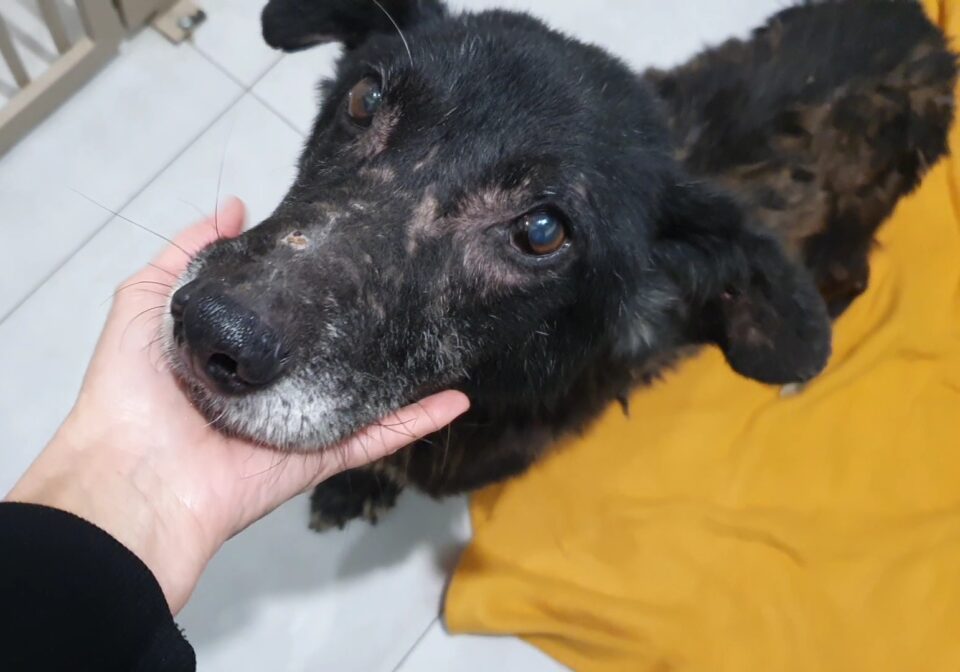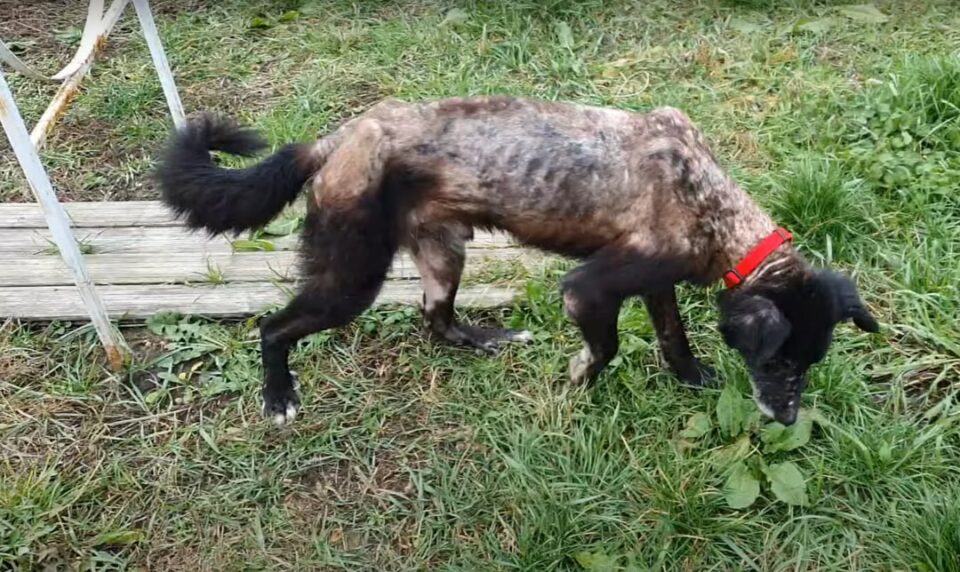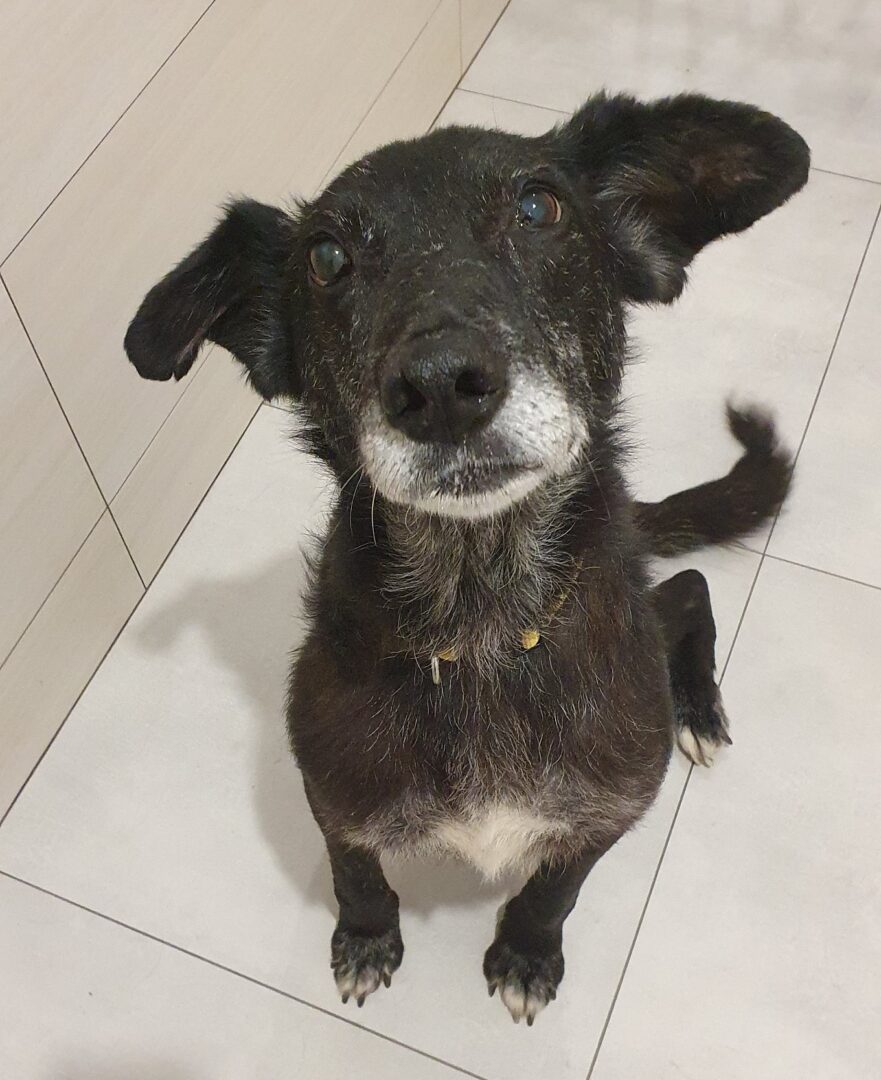Not all dogs have the opportunity to live happily ever after inside a loving home, far away from uncertainty. Many of our four-legged buddies spend their lives hoping that day will finally come… but it never does.
In the vast sea of stories of neglect, one hopeful pair of eyes peaked from his kennel, waiting to be spotted by someone. He spent so much time in a city pound, the facility where stray doggos are kept until they are finally claimed by their owners.
But, he was not claimed. Nor did he have a family to come and pick him up. All he ever had in this world was hope.
A Heartbreaking Rescue

Thanks to the giant-hearted people of Howl Of A Dog, this 10-year-old dog was finally found in one of the kennels. He was calmly sitting there, expressing no emotions with his gentle demeanor. But, boi, his eyes were talking!
If they could speak, they would definitely say something like: “Please, save me, hoomans. I’m not feeling very good!”
He was extremely emaciated and evidently had many health issues.
“We rescued this dog from the city pound, he was emaciated and injured, and sadly, has never received any medical care there,” the Howl Of A Dog team wrote in a Facebook post.
The most heartbreaking thing of all was – he didn’t have a name. He only had an ear tag, indicating that until that day, he was just a number.
Facing Multiple Health Issues

The caring volunteers brought the pup into their facility, and for the first time ever, they gave him hope… and a name! He was now officially named Timmy.
Unfortunately, Timmy’s situation was not ideal. His coat was covered in fleas and lice, and his fur was matted and needed to be shaved completely.
Additionally diagnosed with anaplasmosis, a bacterial tick-borne disease resulting in severe lethargy, decreased appetite, and dehydration, Timmy felt really weak. Other than that, he had gastroenteritis and an old fracture on his leg.
He lived with that pain for years, yet he never stopped hoping that his better days would come.

Thanks to the people who didn’t give up on him, Timmy was finally able to walk on the grass for the first time ever. Living in captivity, in a narrow, concrete kennel, he was never able to taste freedom. But, now he was finally there!
With proper treatment and care, he felt better with every new day. He slowly came out of his shell and started eating normally again.
Underneath those scars from the past blossomed a brand-new pup who was eager to take on new life adventures. Timmy was definitely full of life, but he never had the chance to show how adorable of a pup he was… until now!
He’s No Longer Just A Number

After all this time, it is safe to say that Timmy is no longer just a number! He now has his name, a story, and a big group of friends who’ll take care of him until he finds a proper home.
He has been neutered, microchipped, and vaccinated. Now, it is only a matter of time before this sweet boi meets his forever hoomans and charms them with just the sweetest personality.
It is absolutely safe to say that when he does, he will make an incredible companion!
If you’ve ever shared your life with a furry companion, you know how important their health is. One term that often raises concern among dog owners is distemper. It’s a word that can send shivers down your spine, but understanding what it entails is key to keeping your four-legged friend safe and healthy. Dogs bring so much joy into our lives, and knowing how to navigate potential health issues like distemper is crucial for their well-being.
When it comes to your canine companion, staying informed is your best defense. Distemper isn’t just another word in the veterinary dictionary; it’s a real threat that can impact your dog’s health. By familiarizing yourself with what distemper is and how it can affect your furry friend, you’re taking proactive steps to ensure they lead a long, happy life by your side.
Understanding Distemper in Dogs
When it comes to distemper in dogs, it’s crucial to grasp what this disease entails and how it affects our four-legged friends. Here’s a breakdown to help you navigate through this concerning issue:
Recognizing Distemper Symptoms
Knowing the signs of distemper is key to identifying the disease early on. Look out for symptoms such as fever, nasal discharge, coughing, lethargy, and neurological signs like seizures or twitching.
Transmission and Spread
Distemper is highly contagious and spreads through direct contact with an infected dog’s saliva, urine, or feces. Avoid exposing your dog to unvaccinated or sick animals to prevent the spread of the virus.
Vaccination Importance
Vaccination is the most effective way to protect your dog from distemper. Ensure your furry companion receives timely vaccinations as per your veterinarian’s recommendations to boost their immunity against this disease.
Treatment Options
If your dog is diagnosed with distemper, prompt veterinary treatment is crucial. While there’s no specific cure for distemper, supportive care can help manage symptoms and improve your pet’s chances of recovery.
Prevention Measures
Prevention is always better than cure when it comes to distemper. Maintain your dog’s vaccinations up to date, practice good hygiene habits, and limit their exposure to potentially infected animals.
Staying Informed
Stay informed about distemper updates and guidelines to ensure you’re equipped to protect your canine companion. Regular vet check-ups and awareness of disease trends can help safeguard your dog’s well-being.
By understanding distemper in dogs and taking proactive steps, you play a vital role in keeping your furry friend healthy and happy. Stay vigilant, prioritize vaccination, and provide the care your dog needs to thrive.
Preventing Canine Distemper
Vaccination is the key to preventing canine distemper. Ensure your dog receives the necessary vaccinations according to the schedule recommended by your vet.
Limit your dog’s exposure to potentially infected animals and environments where the virus may be present. Keep your dog away from stray animals and wildlife to reduce the risk of contracting distemper.
Maintain good hygiene practices for your dog, such as regular bathing, cleaning of living areas, and providing clean water and food. A clean environment can help prevent the spread of the virus.
Regular veterinary check-ups are crucial in monitoring your dog’s overall health and ensuring they are up to date on vaccinations. Consult your vet for any concerns or questions regarding distemper prevention.
Educate yourself about the latest information on distemper and stay informed about outbreaks in your area. Being aware of the disease’s prevalence can help you take proactive measures to protect your furry companion.
By following these preventive measures, you can significantly reduce the risk of your dog contracting distemper and help keep them healthy and happy.
Conclusion
Remember, protecting your furry friend from distemper is crucial for their well-being. By staying informed, following your vet’s advice on vaccination, and taking preventive measures like limiting exposure to infected animals and maintaining good hygiene, you can significantly lower the risk of your dog contracting this disease. Regular vet check-ups and staying up-to-date on distemper information are key to keeping your pet healthy and happy. Your proactive approach in preventing distemper will go a long way in ensuring a long and joyful companionship with your beloved dog.
Frequently Asked Questions
What is canine distemper?
Canine distemper is a viral disease that affects dogs, causing respiratory, gastrointestinal, and neurological symptoms. It can be fatal if left untreated.
How is canine distemper transmitted?
Canine distemper is mainly spread through airborne exposure to respiratory secretions from infected dogs. It can also be transmitted through shared food and water bowls.
Why is vaccination important to prevent canine distemper?
Vaccination is crucial in preventing canine distemper as it helps build immunity in dogs, reducing the severity of the disease or preventing it altogether.
What preventive measures can dog owners take?
Dog owners can prevent canine distemper by following a vet-recommended vaccination schedule, limiting exposure to infected animals, maintaining good hygiene practices, scheduling regular vet check-ups, and staying informed about distemper updates.
[no_toc]

Hey there, I’m Janet Brooks, a dog-loving student from California. I’m all about helping pups in need, especially those without homes. Me and my awesome friends work together to give shelter and love to stray dogs. Oh, and I also write blogs about dogs to share helpful info.